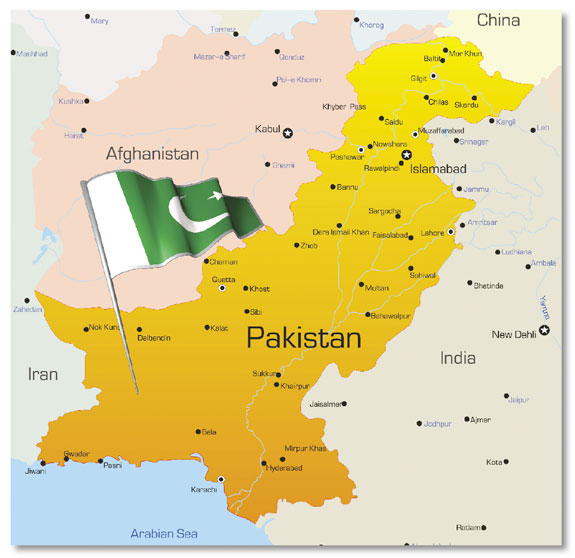Arriving in Pakistan in early December, I have begun my work here as an expeditionary agricultural scientist. My mandate here is largely agricultural reconstruction and stabilization (R&S), and this work is largely in the realm of the third foreign policy pillar of the three D’s: defense, diplomacy and development.

As I have written in these pages already, I am assigned to the State Department as a Civilian Response Corps active member, although I am still an employee at the U.S. Department of Agriculture.
As reported earlier, this country of 185 million people is geographically important given its neighbors of Afghanistan to the west and India to its east.
It is the sixth-largest populated country in the world. And its agricultural program is largely based on irrigated agriculture fed by the Indus River, a large surface water system that runs the entire length of Pakistan, to the south into the Arabian Sea at Karachi, from the northern mountains that include the Hindu Kush and Himalayans.
One common attribute of this assignment and my similar assignments in Afghanistan and Iraq is surface water ⌠the river systems that run through these countries to the south from the north. Entire societies base their civilizations upon these river systems.
People live near them, and farmers use these rivers for the lifeblood of crop production, supplemental water applications in the form of irrigation.
Pakistan is home to the largest network of irrigation agriculture in the world. At one time at least, for today the infrastructure is depreciated and portions are completely destroyed from this summerâs flood events.
Water does not follow political boundaries. And very much like the two major rivers in Iraq (Tigris and Euphrates), the Indus River system originates somewhere outside Pakistan, and portions of the feeder river stems originate and flow from India.
Certainly, when we agriculturalists work with host governments on the topic of water quantities and flow rates, we find ourselves doing so with adjoining countries. For Pakistan, we include India in these discussions.
I have not yet been in the field. My time here in Islamabad is engaging our good friends with the U.S. Agency for International Development. As many of you know USAID is the lead developmental agency in the U.S. government.
I have worked closely with personnel from USAID in Afghanistan and Iraq, and continue to do so here in Pakistan. Generally, USDA agricultural advisers bring subject matter expertise (SME) to the mission.
USAID thinks about projects that will help farmers and farmer cooperatives modernize existing farms and the introduction of new technologies. USAID project managers reach out to us as advisers, bringing field and academic experience to help guide the project during the design and implementation phases.
The goal we seek is simple: economic development that helps farmers increase income and therefore profitability, and just as importantly, stabilizes the food and feed production region so a society remains food secure.
As I have written here before, food security helps a society remain stable and economic development increases quality of life, as income means purchasing of goods and services. I have, at times, thought about this kind of developmental model in the context of what effect we are working towards.
Here in Pakistan, economic development includes modernization of farms; requiring equipment, technology, and service. Farmers here will purchase tractors, combines, hybrid seed, genetics, precision farming equipment, monitoring instruments and marketing technologies as they modernize their farms.
Farmers will adopt new ideas that improve input efficiencies, including improving the ratio of beneficial water use as a function of water applied to crop fields. The technologies are readily available and do not need to be invented. They are accepted in all regions of the irrigated agriculture realm.
Much of my work is done with the overarching end goal of reconstruction and stabilization, and this simply means that we seek a stable society with food security.
Written another way, a society that is food secure is less apt to have food security as a driver of conflict. Many if not most of the regional strife the world over is rooted in control of resources. And one of the most important is water as a critical input for irrigated agriculture, especially outside of the rain-fed system.
This article is largely a general overview of the front end of my assignment here. Over the next three or four articles I will describe my work, and our U.S. government work in greater detail. And I will write of insights and understanding working in yet another country.
In this column, over the last 19 years, I have written of assignments in just over a dozen countries. Some as short as a few weeks and some as long as 16 months in Iraq.
Here in Pakistan, for the next two months, I will pour myself into my work here, understanding that I represent the United States government but also knowing that I must help us use our foreign developmental budgets wisely.
I do this with many other dedicated public servants, entering the world to help our fellow brother and sister, raising the bar of humanity ever so slightly higher, with compassion and empathy and understanding.
This calling is a privilege and, while I am ten time zones away, I am often thinking about the many blessings in our country. I do not take them for granted, and perhaps that is why I think my public service overseas is worthy of an authentic life. PD

-
Mike Gangwer
- Agricultural Scientist
- USDA-NRCS
- Email Mike Gangwer







